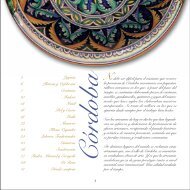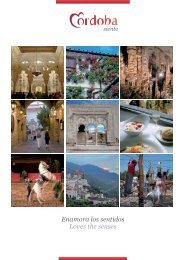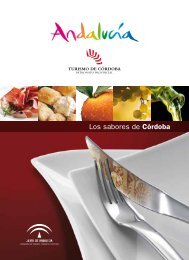o_19hc2l7mb1lfr48u1ie323v160ka.pdf
You also want an ePaper? Increase the reach of your titles
YUMPU automatically turns print PDFs into web optimized ePapers that Google loves.
44-45<br />
El vino<br />
Wine<br />
The Designation of Origin Montilla-<br />
Moriles production framework extends<br />
throughout a large part of the southen<br />
end of the province of Cordoba. The<br />
Genil and Guadajoz rivers create the<br />
eastern and western borders, whereas<br />
the Guadalquivir to the north and the<br />
Subbetica mountains to the south<br />
delimit its girth. Not all of the lands within<br />
these limits are considered suitable to<br />
produce the grape used to make the<br />
wines covered. The selection criterion<br />
is clear: specific types of soil have<br />
already been defined as being ideal for<br />
the vine to grow its best fruit. Article 4 of<br />
the Regulations in effect defines it as:<br />
“The Production Zone for the wines<br />
protected by the Designation of Origin<br />
Montilla-Moriles is comprised of the<br />
lands the Regulatory Council deems<br />
suitable for the production of the grape<br />
varieties outlined in article 5, with the<br />
quality necessary to be used to make<br />
such wines. These lands are located<br />
within the municipal borders of Montilla,<br />
Moriles, Doña Mencía, Montalbán,<br />
Monturque, Nueva Carteya and<br />
Puente Genil, and parts of Aguilar de la<br />
Frontera, Baena, Cabra, Castro del<br />
Río, Espejo, Fernán-Núñez, La Rambla,<br />
Lucena, Montemayor and Santaella".<br />
The soil and climate are essential<br />
factors in the quality of all wines and,<br />
especially, in that of the generosos<br />
made and aged under the designation<br />
of origin Montilla-Moriles.<br />
The calcium carbonate rich lagoons<br />
feature soils and subsoils formed by<br />
soft marlstone which is poor in natural<br />
organic matter and not very fertile with a<br />
simple mineral composition (basically<br />
limestone and silica). The structure is<br />
flaky or lumpy, the percentage of<br />
chloride and sulphates is scarce and<br />
the subsoil has a high moisture<br />
retention capacity of around 30%.<br />
The climate of Montilla-Moriles is<br />
basically Mediterranean but with a<br />
certain continental aspect given its







